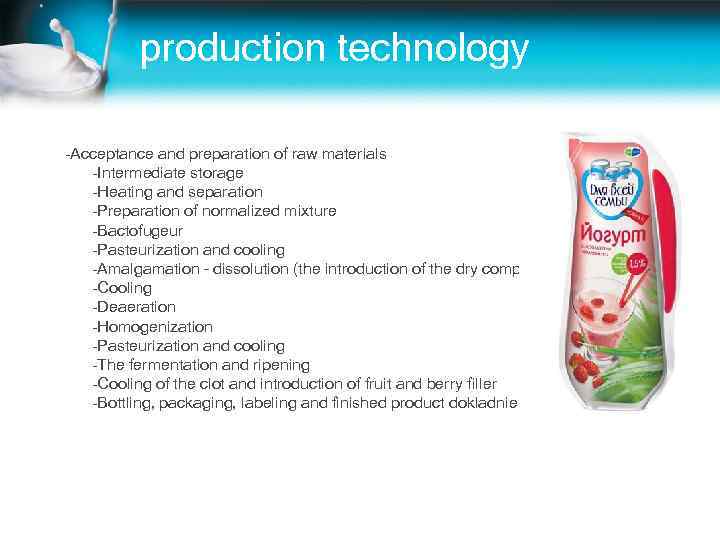Yogurt Fulfilled: Biktuganov A. H.


Yogurt Fulfilled: Biktuganov A. H.

What is the yogurt? Yogurt is a fermented milk product with high content of dry skimmed milk substances produced using a mixture of starter microorganisms — thermophilic lactic streptococci and Bulgarian lactic acid Bacillus.

Organoleptic indicators Name of the indicator property Homogeneous, moderately viscous. When adding stabilizers, jelly-like or Appearance and consistency creamy. When using flavoring food additives with the presence of their impurities. Milk, without foreign tastes and odors. When formulating with sugar Taste and smell or sweetener — moderately sweet. When formulating with flavoring and food additives, taste and flavors with the appropriate taste and flavor component mix application rate. Milky white, uniform throughout the mass. When formulating with color flavoring food additives and food dyes is caused by the color made ingredient.

The history of yogurt The word "yogurt" is of Turkish origin (Turkish: yoğurt), and means "condensed". The Scythians and related to them nomadic peoples have long been transported milk in skins on the backs of horses and donkeys. Out of the air and wool in the product got the bacteria, the heat was fermentation, and the constant shaking did the rest, turning milk into a thick sour drink that long to spoil and kept all useful properties. The birthplace of yogurt, and Central Asia. In Europe some fame yogurt acquired due to disease of the stomach of king Louis XI. The king could not heal, and he was helped by a doctor from Constantinople, which brought him the Balkan yoghurt. In the USSR, the yoghurt produced from 1920 -ies. It was sold in pharmacies as a remedy called agent.

Structure yogurt A typical composition of fruit yogurt the following: • Fat 0. 5 – 3. 0% of • Lactose 3 – 4, 5% • Dry non-fat milk residue (SOMO)11 – 13% • Stabilizer (if using) 0, 3 – 0, 5% • Fruit Supplement 12 – 18% Yogurt is rich in calcium , phosphorus, iodine, vitamins B 2 and B 12, it contains ascorbic acid, choline, retinol, vitamin e, vitamins B 1, B 3, B 6, D, organic and fatty acids, and potassium in it as much as in bananas. Other minerals that are present in yogurt: magnesium, sodium, sulfur, iron, manganese, chromium, zinc, fluorine

Types of yogurt There are three main types of yogurt: -Unscented -Flavored -With fruit pieces Depending on the fat content: 1. Dairy low-fat (fat content of not more than 0. 1%); low-fat (1%); bold (up 2. 5%); classic (to 4. 5%); 2. Milk-cream (7%); 3. Cream and milk (to 9. 5%); 4. Cream (fat content more than 10%). Furthermore, yogurts are: - Jameed - Soy yogurt – jofu - Icelandic yogurt - Skiri - Greek yogurt - Kefir yogurt

Useful properties -Improves the work of stomach, well nourishes and quenches thirst; -Helps to restore and maintain a healthy balance in the intestines: prevents the growth of putrefactive bacteria, detrimental effect on pathogens of gastrointestinal diseases, stimulates the growth of beneficial micro-organisms, cleanses the intestines of toxins, improves digestion, promotes better digestion; -Boosts immunity and serves as a prevention of the following diseases: atherosclerosis, fungal infections, leukocytosis, hypertension, colon cancer. Helps prevent disease of heart, blood vessels, bones and joints; -Due to the high content of calcium and vitamin D supports healthy bones and teeth; Helps in the treatment of urinary tract infections, colitis, peptic ulcer disease, tuberculosis, cholecystitis, chest pediatric asthma, boils; -Live low-fat yogurt eases the weight loss process; -Due to the content of zinc helps fight acne, acne and skin inflammations

production technology -Acceptance and preparation of raw materials -Intermediate storage -Heating and separation -Preparation of normalized mixture -Bactofugeur -Pasteurization and cooling -Amalgamation – dissolution (the introduction of the dry components) -Cooling -Deaeration -Homogenization -Pasteurization and cooling -The fermentation and ripening -Cooling of the clot and introduction of fruit and berry filler -Bottling, packaging, labeling and finished product dokladnie

How to choose a yogurt? • Choose plain yogurt • To obtain yoghurt milk needed and two bacterial cultures - Lactobacillus Bulgaricus and Streptococcus Thermophilus. • Look for beneficial bacteria • Probiotics are a key element of yogurt. • Calcium • Look for yogurt that contains at least 15% of daily calcium. Ideal - from 15 to 35%. • Check the sugar • Avoid foods, as part of which the sugar is in the first or second place. • Avoid fruit • Ensure that natural fruits and berries added to the yogurt - among the ingredients they need to stand at the very beginning. • Do not be afraid of fat • Low-fat yogurts contain a lot of sugar. • Shelf life • Ideally, five to seven days maximum - 30 -35 days. • Carefully read the label

Thank you for attention!

